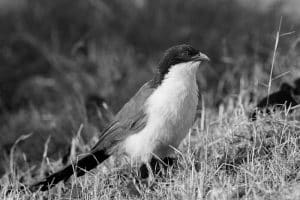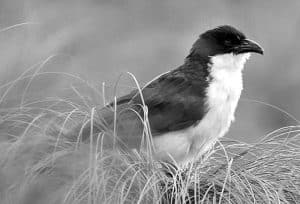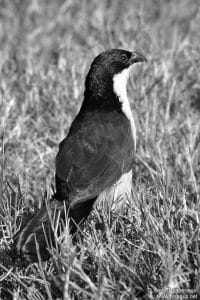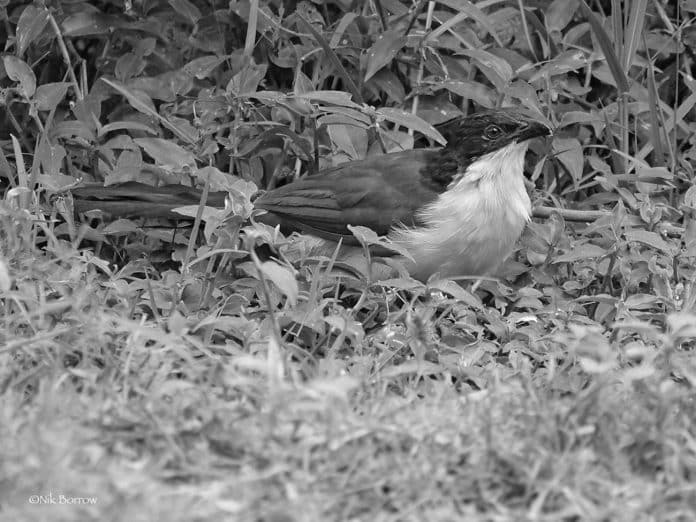Introduction to the Blue-Headed Coucal
The Blue-Headed Coucal in Tanzania (Centropus monachus) is an exquisite bird species that finds its place within the cuckoo family. This avian wonder’s name is a nod to its captivating blue head, which creates a stunning contrast with its sleek black body and gracefully long tail. What’s particularly intriguing is that both the male and female Blue-Headed Coucals share similar appearances, making distinguishing between the sexes quite a challenge. This remarkable species is celebrated for its distinctive calls, which serenade the early morning and late afternoon hours in the beautiful Tanzanian landscape..
Habitat and Distribution of the Blue-Headed Coucal in Tanzania

The Blue-Headed Coucal is native to the wetlands and swamps of Tanzania. These birds are typically found in the eastern and southern regions of the country, where they inhabit areas with dense vegetation and shallow water. They are particularly fond of papyrus swamps and marshes, where they build their nests and raise their young. The Blue-Headed Coucal is a resident bird in Tanzania, meaning that it does not migrate and can be seen throughout the year.
Physical Features and Adaptations of the Blue-Headed Coucal
One of the most striking features of the Blue-Headed Coucal is its vibrant blue head, which is adorned with a crown-like pattern. This blue coloration is believed to be a result of the bird’s diet, which consists mainly of insects and small reptiles. The Blue-Headed Coucal has a long, curved bill, which it uses to catch its prey. Its strong legs and sharp claws enable it to navigate through dense vegetation and walk on floating vegetation in the swamps. With its streamlined body and long tail, the Blue-Headed Coucal is well-adapted for life in the wetlands.
Behavior and Reproduction of the Blue-Headed Coucal
The Blue-Headed Coucal is a solitary bird that is often seen perched on low branches or walking on the ground in search of food. It is known for its secretive nature, often hiding in the dense vegetation of the swamps. During the breeding season, which typically occurs from October to March, the male Blue-Headed Coucal performs an elaborate courtship display to attract a mate. This display includes fluffing up its feathers, spreading its wings, and calling loudly. Once a pair forms, they will build a nest together, usually in a dense clump of papyrus or reeds. The female lays 2-4 eggs, which she incubates for about 20 days. Both parents take turns caring for the eggs and feeding the chicks once they hatch.
Diet and Feeding Habits of the Blue-Headed Coucal

The Blue-Headed Coucal is an insectivorous bird, feeding primarily on insects, spiders, and small reptiles. It is known to be an opportunistic feeder, taking advantage of any prey it comes across during its foraging activities. The bird uses its long, curved bill to probe into the vegetation and catch its prey. It is also known to snatch prey from the air or from the ground. The Blue-Headed Coucal has been observed using its bill to remove the wings or legs of larger insects before swallowing them whole.
Conservation Status and Threats to the Blue-Headed Coucal
The Blue-Headed Coucal is currently listed as a species of least concern by the International Union for Conservation of Nature (IUCN). However, its population is believed to be declining due to habitat loss and degradation. Wetland destruction, caused by agriculture, urbanization, and drainage for mosquito control, poses a significant threat to the Blue-Headed Coucal’s habitat. Additionally, pollution and the introduction of invasive species further exacerbate the challenges faced by this species. It is crucial to raise awareness about the importance of wetland conservation and implement measures to protect the habitats of the Blue-Headed Coucal and other wetland-dependent species.
Blue-Headed Coucal Sightings and Birdwatching in Tanzania
Tanzania offers an excellent opportunity for birdwatchers to spot the Blue-Headed Coucal in its natural habitat. The wetlands and swamps of the country provide ideal conditions for this species to thrive. Birdwatching tours and guided excursions are available, allowing visitors to explore the diverse avian life of Tanzania, including the Blue-Headed Coucal. If you are planning a trip to Tanzania, be sure to include birdwatching in your itinerary, and you may be rewarded with a sighting of this enchanting bird.
Interesting Facts about the Blue-Headed Coucal

- The Blue-Headed Coucal is known for its distinctive call, which has been described as a loud, echoing “boop-boop-boop.”
- Despite its striking appearance, the Blue-Headed Coucal can be challenging to spot due to its elusive nature and preference for dense vegetation.
- The Blue-Headed Coucal is a skilled vocal mimic and can imitate the calls of other bird species, adding to its allure and mystery.
- This species is monogamous, with pairs forming strong bonds that last throughout the breeding season.
- The Blue-Headed Coucal plays an important role in the ecosystem by controlling insect populations, particularly those of agricultural pests.
Conservation Efforts and Initiatives for the Blue-Headed Coucal
Several conservation organizations and initiatives are working to protect the Blue-Headed Coucal and its habitat in Tanzania. These organizations focus on raising awareness about the importance of wetland conservation, conducting research on the species, and implementing measures to mitigate the threats faced by the Blue-Headed Coucal. It is essential to support these efforts through donations, volunteering, and responsible tourism practices to ensure the long-term survival of this magnificent bird.
Conclusion
The Blue-Headed Coucal is truly a remarkable bird, with its vibrant blue head and captivating presence. Found in the wetlands and swamps of Tanzania, this species enchants birdwatchers and nature enthusiasts with its beauty and unique behaviors. While the Blue-Headed Coucal faces threats such as habitat loss and degradation, conservation efforts are underway to protect this species and its delicate ecosystem. By raising awareness, supporting conservation initiatives, and promoting responsible tourism, we can ensure that the Blue-Headed Coucal continues to thrive in Tanzania’s enchanting wetlands for generations to come.

































